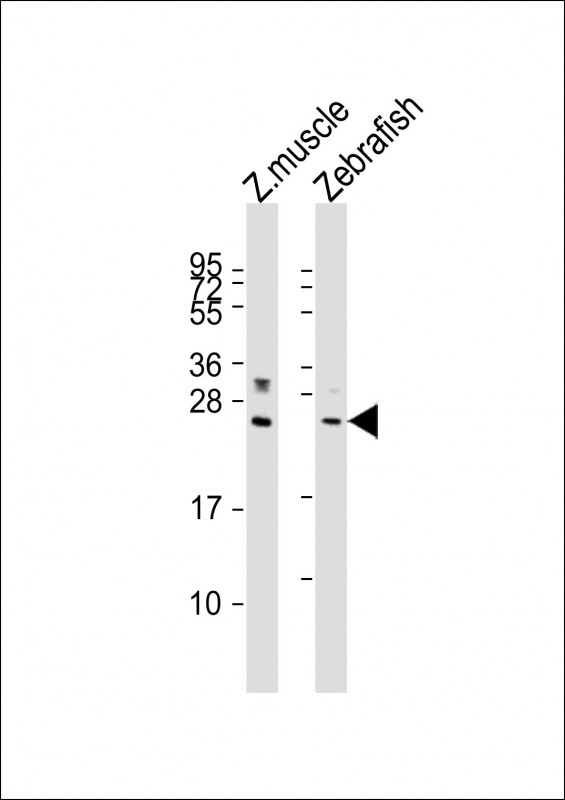(DANRE) lin28a Antibody (Center)
Purified Rabbit Polyclonal Antibody (Pab)
- SPECIFICATION
- CITATIONS
- PROTOCOLS
- BACKGROUND

Application
| WB, E |
|---|---|
| Primary Accession | Q803L0 |
| Reactivity | Zebrafish |
| Host | Rabbit |
| Clonality | polyclonal |
| Isotype | Rabbit IgG |
| Calculated MW | 21886 Da |
| Antigen Region | 85-119 aa |
| Gene ID | 394066 |
|---|---|
| Other Names | Protein lin-28 homolog A, Lin-28A, lin28a, lin28 |
| Target/Specificity | This DANRE lin28a antibody is generated from a rabbit immunized with a KLH conjugated synthetic peptide between 85-119 amino acids from the Central region of DANRE lin28a. |
| Dilution | WB~~1:2000 E~~Use at an assay dependent concentration. |
| Format | Purified polyclonal antibody supplied in PBS with 0.09% (W/V) sodium azide. This antibody is purified through a protein A column, followed by peptide affinity purification. |
| Storage | Maintain refrigerated at 2-8°C for up to 2 weeks. For long term storage store at -20°C in small aliquots to prevent freeze-thaw cycles. |
| Precautions | (DANRE) lin28a Antibody (Center) is for research use only and not for use in diagnostic or therapeutic procedures. |
| Name | lin28a |
|---|---|
| Synonyms | lin28 |
| Function | RNA-binding protein that inhibits processing of pre-let-7 miRNAs and regulates translation of mRNAs that control developmental timing, pluripotency and metabolism. Seems to recognize a common structural G-quartet (G4) feature in its miRNA and mRNA targets (By similarity). 'Translational enhancer' that drives specific mRNAs to polysomes and increases the efficiency of protein synthesis. Its association with the translational machinery and target mRNAs results in an increased number of initiation events per molecule of mRNA and, indirectly, in mRNA stabilization. Suppressor of microRNA (miRNA) biogenesis, including that of let-7. Binds specific target miRNA precursors (pre-miRNAs), recognizing an 5'-GGAG-3' motif found in their terminal loop, and recruits uridylyltransferase. This results in the terminal uridylation of target pre-miRNAs. Uridylated pre-miRNAs fail to be processed by Dicer and undergo degradation (By similarity). Localized to the periendoplasmic reticulum area, binds to a large number of spliced mRNAs and inhibits the translation of mRNAs destined for the ER, reducing the synthesis of transmembrane proteins, ER or Golgi lumen proteins, and secretory proteins. Binds to and enhances the translation of mRNAs for several metabolic enzymes, increasing glycolysis and oxidative phosphorylation. Which, with the let-7 repression may enhance tissue repair in adult tissue (By similarity). |
| Cellular Location | Cytoplasm {ECO:0000250|UniProtKB:Q8K3Y3}. Rough endoplasmic reticulum {ECO:0000250|UniProtKB:Q8K3Y3}. Cytoplasm, P-body {ECO:0000250|UniProtKB:Q9H9Z2}. Cytoplasm, Stress granule {ECO:0000250|UniProtKB:Q8K3Y3}. Nucleus, nucleolus {ECO:0000250|UniProtKB:Q8K3Y3}. Note=Predominantly cytoplasmic. In the cytoplasm, localizes to peri-endoplasmic reticulum regions and may be bound to the cytosolic surface of rough endoplasmic reticulum (ER) on which ER-associated mRNAs are translated. Shuttle from the nucleus to the cytoplasm requires RNA-binding. {ECO:0000250|UniProtKB:Q8K3Y3} |

Thousands of laboratories across the world have published research that depended on the performance of antibodies from Abcepta to advance their research. Check out links to articles that cite our products in major peer-reviewed journals, organized by research category.
info@abcepta.com, and receive a free "I Love Antibodies" mug.
Provided below are standard protocols that you may find useful for product applications.
Background
Acts as a 'translational enhancer', driving specific mRNAs to polysomes and thus increasing the efficiency of protein synthesis. Its association with the translational machinery and target mRNAs results in an increased number of initiation events per molecule of mRNA and, indirectly, in stabilizing the mRNAs. Acts as a suppressor of microRNA (miRNA) biogenesis by specifically binding the precursor let-7 (pre-let-7), a miRNA precursor. Acts by binding pre-let-7 and recruiting an uridylyltransferase, leading to the terminal uridylation of pre- let-7. Uridylated pre-let-7 miRNAs fail to be processed by Dicer and undergo degradation. Specifically recognizes the 5'-GGAG-3' motif in the terminal loop of pre-let-7. Also recognizes and binds non pre-let-7 pre-miRNAs that contain the 5'-GGAG-3' motif in the terminal loop, leading to their terminal uridylation and subsequent degradation (By similarity).
References
Howe K.,et al.Nature 496:498-503(2013).
Lemeer S.,et al.J. Proteome Res. 7:1555-1564(2008).
If you have used an Abcepta product and would like to share how it has performed, please click on the "Submit Review" button and provide the requested information. Our staff will examine and post your review and contact you if needed.
If you have any additional inquiries please email technical services at tech@abcepta.com.













 Foundational characteristics of cancer include proliferation, angiogenesis, migration, evasion of apoptosis, and cellular immortality. Find key markers for these cellular processes and antibodies to detect them.
Foundational characteristics of cancer include proliferation, angiogenesis, migration, evasion of apoptosis, and cellular immortality. Find key markers for these cellular processes and antibodies to detect them. The SUMOplot™ Analysis Program predicts and scores sumoylation sites in your protein. SUMOylation is a post-translational modification involved in various cellular processes, such as nuclear-cytosolic transport, transcriptional regulation, apoptosis, protein stability, response to stress, and progression through the cell cycle.
The SUMOplot™ Analysis Program predicts and scores sumoylation sites in your protein. SUMOylation is a post-translational modification involved in various cellular processes, such as nuclear-cytosolic transport, transcriptional regulation, apoptosis, protein stability, response to stress, and progression through the cell cycle. The Autophagy Receptor Motif Plotter predicts and scores autophagy receptor binding sites in your protein. Identifying proteins connected to this pathway is critical to understanding the role of autophagy in physiological as well as pathological processes such as development, differentiation, neurodegenerative diseases, stress, infection, and cancer.
The Autophagy Receptor Motif Plotter predicts and scores autophagy receptor binding sites in your protein. Identifying proteins connected to this pathway is critical to understanding the role of autophagy in physiological as well as pathological processes such as development, differentiation, neurodegenerative diseases, stress, infection, and cancer.


